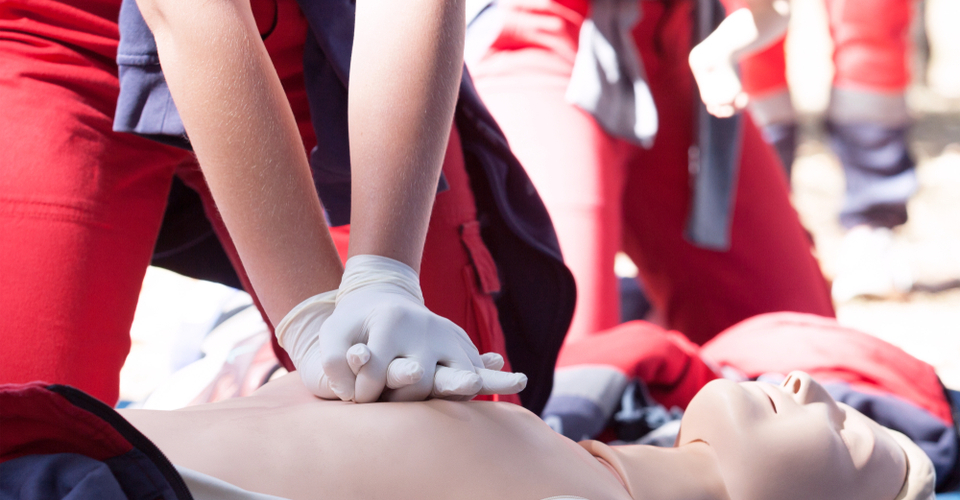What Best Describes the Purpose for Hands Only Cpr
There is strong evidence that the longer CPR is delayed the. For an Adult 2 person CPR is 30 compressions 2 breaths.

What Is Hands Only Cpr American Heart Association Cpr Training First Aid Cpr
As you might have guessed in this method you only use your hands to perform chest compressions to keep blood flowing.

. Also Hands-Only CPR is an easy-to-remember and effective option for people who have been trained in CPR before but are afraid to help because they are not confident that they can remember. Hands-only CPR which is also known as compression-only CPR is probably better termed compression-only resuscitation because it does not involve rescue breaths. Hands-Only CPR Study and Video Resources Access additional resources for Hands-Only CPR including the study behind the training videos printable resources social media assets and more.
Hands-only CPR is now the only method for providing CPR regardless your level of education and expertise. AHands-only CPR is better and more effective than full CPR and is now the best way to provide CPR for any patient by any responderBHands-only CPR reduces risk of liability and increases oxygenation better than CPR with mouth-to-mouth resuscitationCHands-only CPR is now the only method. Surveys Americans who had not been trained in CPR within the past five years said they would be more likely to perform Hands-Only CPR on a teen or adult who collapses suddenly.
Hands only CPR is CPR technique where only chest compressions are delivered instead of chest compressions rescue breaths artificial respiration in conventional CPR. Hands-Only CPR is an effective way for any bystander to. Hands-only CPR was designed for those who are not trained or feel uncomfortable delivering mouth-to-mouth breaths.
What is the purpose of hands-only CPR. Hands-only CPR was designed for those who are not trained or feel uncomfortable delivering mouth-to-mouth breaths. One person does the compressions the other.
Hands-only CPR was designed for those who are not trained or feel uncomfortable delivering mouth-to-mouth breaths. In a standard CPR procedure you would do 30 chest compressions followed by two rescue breaths and then repeat the cycle. Hands-only CPR is now the only method for providing CPR regardless your level of education and expertise.
The purpose of hands-only CPR is to get blood pumping through the victims body until paramedics arrive on the scene and perform more advanced life support. Hands-Only CPR helps to maintain brain and heart function and two studies have researched the effectiveness of it. What is hands-only CPR.
CPR stands for Cardiopulmonary Resuscitation which includes two rescue breaths for every 100 compressions per minute Lets take a look at how compression-only resuscitation works. Only perform CPR on an unresponsive victim. Both studies appeared in the New England Journal of Medicine and had similar positive results.
It serves two purposes. View the CPR Guide Infographic and additional resources. As a result CPR is often delayed.
Hands-only CPR reduces risk of liability and increases oxygenation better than CPR with mouth-to-mouth resuscitation. Perform chest compressions Place the heel of your hand on the center of the chest midway between the nipples. Hands-only CPR reduces risk of liability and increases oxygenation better than CPR with mouth-to-mouth resuscitation.
Hands-only CPR reduces risk of liability and increases oxygenation better than CPR with mouth-to-mouth resuscitation Hands-only CPR is now the only method for providing CPR regardless your level of education and expertise Hands-only CPR was designed for those who are not trained or feel uncomfortable delivering mouth-to-mouth breaths. The second is to encourage people to perform CPR on a cardiac arrest victim who would otherwis. Place the other hand over the hand.
Hands-only CPR reduces risk of liability and increases oxygenation better than CPR with mouth-to-mouth resuscitation. When the scene becomes unsafe when the victim begins to move and breathe normally andor when another trained person arrives to take over. One is to provide compressions circulating blood without the risk of infection associated with mouth-to-mouth contact.
Which of these best describes the purpose for hands-only CPR. Hands only CPR was designed for those who are not trained or feel uncomfortable delivering mouth-to0mouth breaths. Hands-only CPR is now the only method for providing CPR regardless your level of education and expertise.
Which of these best describes the purpose for hands-only CPR Hands only CPR was designed for those who are not trained or feel uncomfortable delivering mouth-to0mouth breaths. Hands only CPR reduces the risk of liability and increases oxygenation better than CPR with mouth to mouth After CPR has been started when is an appropriate time to stop. What best describes how you and a second rescuer can give CPR to an adult victim together.
Hands-only CPR reduces risk of liability and increases oxygenation better than CPR with mouth-to-mouth resuscitation. How to perform Hands-Only CPR on a child 1 year or adultCall 9-1-1 or direct someone to call 9-1-1. Answer 1 of 4.
Which of these best describes the purpose for hands-only CPR. The idea behind hands only CPR is that many bystanders are unwilling to perform rescue breaths on a stranger. This answer is pretty straightforward.
Jason Grady System Manager for Emergency Cardiac Care at Northside Hospital in Georgia speaks about mouth-to-mouth resuscitation or rescue breathing and how hands-only CPR can be sufficient. The rate of survival and brain damage were similar when Hands-Only CPR and regular CPR compressions and giving breaths were performed. It doesnt replace traditional CPR When delivering rescue breaths on an infant by mask what is the most important aspect regarding the use of a rescue mask.

What Is Hands Only Cpr A Lifesaving Technique Within Your Reach Procpr

How To Position Your Hands For Cpr

What Is Hands Only Cpr Life Enriching Communities

Screenshot Hands Only Cpr By The American Heart Association Jive Media Download Scientific Diagram
Comments
Post a Comment